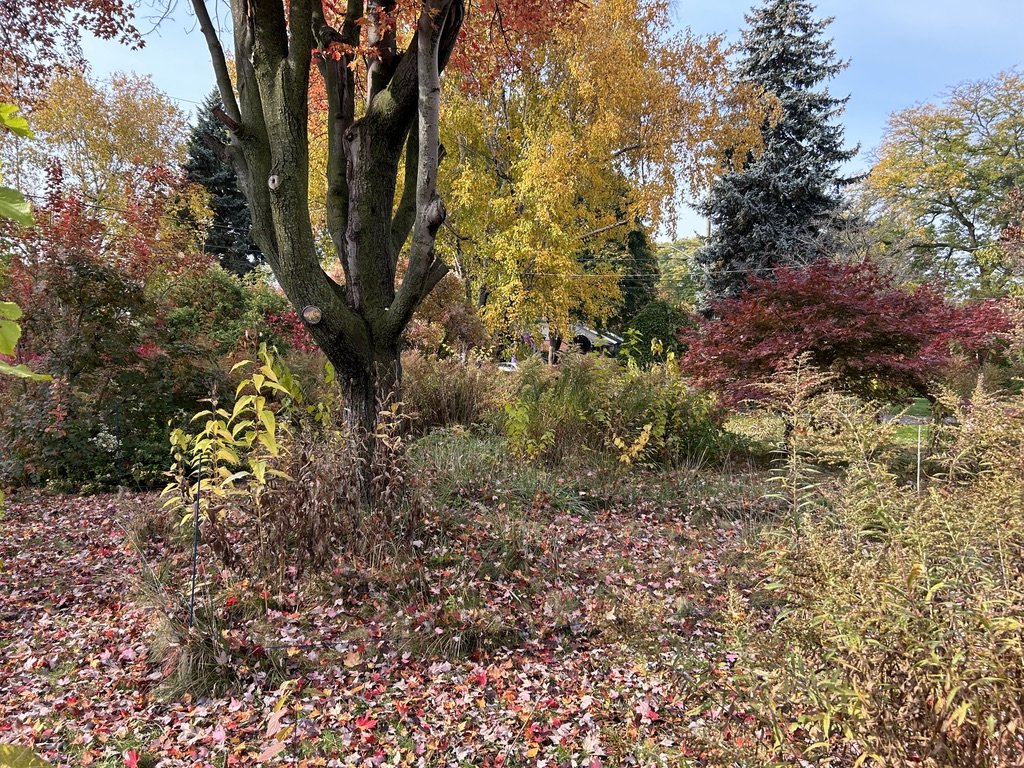Emily Noel reached out to me a few years ago with a question about some native woodland plants that were struggling in her shade garden. I suggested amending the soil with compost and mimicking a forest floor by adding dead leaves to the bed and replenishing them every year. I encouraged her whole-heartedly in this soil-boosting and pollinator-friendly practice, and, as far as I knew, that was the end of it.
Little did I expect that Emily could be busted for following my advice.
Emily lives in Oshawa, and has been gardening for about five years in the front yard, back yard, and boulevard. She’s included many native plants in her garden (golden Alexanders, prairie smoke, eastern wild columbine, Virginia mountain mint, little bluestem, tufted hair grass, among others) along with non-natives she hoped would make the neighbours happy and appease any concerns they might have.
Despite Emily’s efforts, and some neighbours telling her they love her flowers, someone complained about the leaves in her garden. In Oshawa, leaves are explicitly included in the bylaw definition of “waste” and must be removed.
The “offending” leaves in Emily’s boulevard garden. (Photo courtesy of Emily Noel)
When a bylaw officer showed up a few weeks ago to warn Emily that there had been a complaint and to inspect her garden, Emily was armed with print-outs. (A neighbour had been yelling at Emily about her leaves, so she was anticipating some trouble.) Oshawa is a “Bee City” and so Emily showed the officer the text where Bee City recommends leaving the leaves as crucial pollinator habitat. Indeed, in Oshawa’s 2021 report to Bee City, the municipality notes that “The biggest challenge is shifting the perspective of citizens from a mindset that considers lawns or parks with weeds as undesirable, or un-raked lawns over winter as unsightly.” In the report, the City then commits to promoting “a paradigm shift in public attitude.” Apparently, the bylaw department didn’t get the memo.
Emily also showed him a print-out from the City’s website. In a section called “What you can do for pollinators,” it says “Leave…leaves, dry stems and dead branches to create habitat.” Emily pointed out that she was following the City’s own advice.
(Photo courtesy of Emily Noel)
None of that mattered, according to the officer. The bylaw is clear. Leaves are waste that must be removed.
He agreed to speak with his supervisor. First, though, he asked Emily if she’d consider removing the leaves, and Emily responded with an emphatic “NO.”
One can only guess what the Supervisor said, but another bylaw officer arrived several days later, again to discuss removing the leaves. The meeting did not go well, says Emily.
Although the bylaw officers were focused on the leaves as an infraction, Emily is also in contravention of a clause in Oshawa’s boulevard bylaw. This bylaw allows plants other than turfgrass on the boulevard, as long as the vegetation doesn’t exceed 3ft in height; Emily’s low-growing plants don’t exceed that height limit. But the bylaw also requires that boulevard plantings be set back 2ft from the sidewalk and 4ft from the road curb, essentially disallowing any landscaping on boulevards that are narrower than 6ft, as most are. Emily’s boulevard is wider than that, but her planting does not include a setback.
(Photo courtesy of Emily Noel)
Some people might be intimidated or unprepared to spend the time and effort, and emotional resources, required to fight bad bylaws that cause harm when you’re doing good. Not Emily. She’s spent years as a volunteer working to green Oshawa. She’s a David Suzuki Foundation Butterflyway Ranger and has done training on habitat creation. She sat on the Oshawa Environmental Advisory Committee and wrote a critique of the City’s boulevard policies, making recommendations to enable plantings other than turfgrass in these quasi-public spaces the adjacent resident is required to maintain. And now she’s leading an effort to reform Oshawa’s property standards bylaws.
And do Oshawa’s bylaws ever need reforming! Both the Lot Maintenance bylaw and the Property Standards bylaw prohibit having nurse logs, brush piles, leaves, and garden clippings (no “Chelsea Chop” allowed here!) in the yard. Not only are these pollinator-supporting and soil-building practices outlawed, but the Property Standards bylaw also mandates that your garden must be maintained with “a good appearance” and be “in harmony with the neighboring environment.” It must also be “clean and tidy.”
Oshawa’s bylaw requires that your landscape be “in harmony with the neighboring environment.” In Emily’s case, that means lawns. (Photo courtesy of Emily Noel)
Such vague terminology, open to subjective interpretation, has already been ruled “unenforceable” by the Ontario Court of Justice in the Sandy Bell decision decades ago. Unfortunately, Oshawa is not alone in keeping an unconstitutional bylaw on the books and in enforcing it, too.
It’s only when people stand up and fight back, or work proactively with their municipalities to change these bad bylaws, that habitat gardens will be safe from arbitrary enforcement.
If the City of Oshawa doesn’t back down, Emily is prepared to fight this. (She meant it when she said “NO” to removing the leaves.) Emily is hoping to work collaboratively with the City to amend the bylaws in support of pollinators. If it comes to a legal fight, though, she’ll start a GoFundMe.
(Photo courtesy of Emily Noel)
In the meantime, please help to reform these bad bylaws and enforcement practices across the country by clicking on the David Suzuki Foundation Action Alert below. This is one simple and immediately do-able way to let your municipality know that you support habitat gardens and you want bylaws and enforcement practices that support, rather than punish, them.











